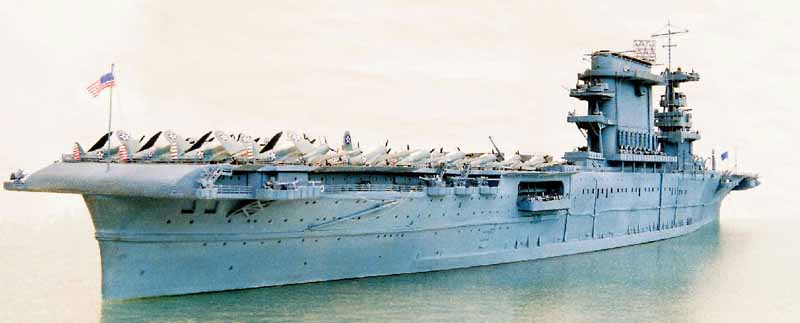by Chris Smithers

1/350 USS Lexington CV-2 (Trumpeter)

Modelled as in April 1942 following final refit and preparing to depart from Pearl Harbour en-route to The Battle of the Coral Sea, where the ship was lost.
This is the first 1/350 scale model warship I’ve built. Given how long it took, it may well be the last. On reflection, building a replica of what was the world’s largest warship throughout her lifetime was perhaps over-ambitious. Perhaps starting in this scale with a whale boat would have been a better idea.
If you like your models smothered with light automatic AA weapons, then you’re in for a treat. If not, then steer well clear of this subject.
The other problem is – it’s an aircraft carrier. The real issue is whether you are prepared to put in the time to build dozens – literally dozens – of tiny 1:350 scale aeroplanes. Because ship modelling this is not.
Overall, however, what a sad disappointment this kit is. The quality (or lack) of accuracy places it in my mind in the market for mass-produced kits of popular subjects. How can this be? If it was a Missouri or a Bismarck it would be excusable. But surely, the market for, at best, a marginal subject, depicted at a very time-constrained period in its history (three weeks or less) can only be very small and restricted to a small band of model warship enthusiasts. The very fact that White Ensign Models received only twelve advance orders for their proposed photo-etched set within three months of the release of this model indicates the narrow scope of likely interest.
Therefore, what a huge lost opportunity this represents. For a small group of enthusiasts like myself, the release of this kit was akin to an answer to a maiden’s prayer. Not only is it the Lexington. It is the Lexington at the time of the Battle of the Coral Sea. Not only that, it’s in 1:350 scale. It just couldn’t get any better. Unfortunately, it could. What astonishes me is the effort that must have gone into fictionalising so much of the detail when so much effort could have been saved simply by mimicking the builders’ plans.
The Floating Drydock Company plans represent the ship as first completed. Although they are marked up with subsequent changes, the references are to other drawings that are not available (at least from The Floating Drydock Company). Having said this, builders’ drawings are never the whole truth. They still have to be cross-referenced with photographic sources. Fortunately the Lexington was the subject of a lot of photographic coverage in the pre-war era, especially in relation to the widening of the flight deck at the bow and the installation of light AA platforms at the quarters and on the stack.
The areas of greatest conjecture surround the details of her refit prior to the Battle of the Coral Sea. All the surviving photos from this period are published in Classic Warships Publishing Warship Pictorial #11, Lexington Class Carriers. Combining these with textual descriptions in ‘The Lexington Class Carriers’ (Robert C Stern) provides the best possible basis for making judgements on these details.
Key facts
Took two years to build, comprising 261 hours (37 days work)
Kit parts: 553
Scratch parts: 1301
PE parts: 648
Resin parts: 49
Turned brass parts: 12
Laser-cut wood parts: 2
Decals: 132
Total parts: 2697
Approximate cost £ sterling
Kit 80
Nautilus laser-cut wooden flight deck 40
Floating Drydock Co. plans 20
Gold Medal Models (GMM) PE set 20
L’Arsenal 5-inch mounts 20
L’Arsenal 5-inch turned brass barrels 13
WEM Colourcoat paint 14
Trumpeter Douglas TBD-1 x 10 9
Trumpeter Douglas SBD-3 x 10 9
WEM 1.1-inch quad PE sets 8
L’Arsenal crew figures 35
Voyager USN life rafts 7
Custom built glass case 59
Aluminium edging 6
Name plate 11
Total 351
